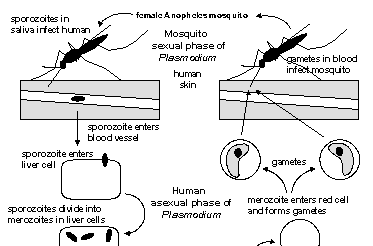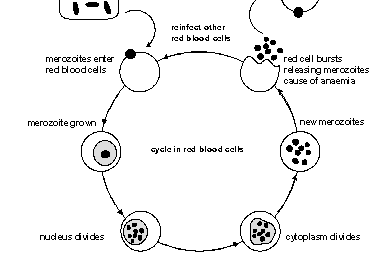

after GHAST Biology SSS
This lesson provides the teacher with material to teach the life cycle of malaria on the SSS level according to "Biology for Senior Secondary School".
Topic
Instructional Objectives
Reference Books
Teaching and Learning
Aids to Be Used
Students Previous Knowledge
Presentation of
Lesson or Methodology
Remarks
Back to "Teaching Materials Malaria"
Malaria is one of the most important infectious diseases in the tropics, causing one to two million deaths a year worldwide. Unlike other infectious diseases as tuberculosis and AIDS, malaria can be cured easily, if treated in time. Teaching the life cycle of malaria is one way of rising awareness towards this disease and can, if properly understood, help to prevent unnecessary suffering among the affected population.
Back to Orientation "SSS Lesson"
1. Life cycle of the malarial agents in humans and anopheline host in three major steps.
Back to Orientation "SSS Lesson"
GHAST Biology for Senior Secondary School, page 187, figure 10.18; see Malaria (in German)
Back to Orientation "SSS Lesson"
For this lesson you need the figure 10.18 out of the GHAST Biology for Senior Secondary School or the schematic drawing (GHAST errors corrected) provided here.
 |
|
 |
Drawing "Malaria life cycle"
after GHAST Biology SSS |
Text "Malaria life cycle"The life cycle of the four malaria parasites Plasmodium falciparum, Plasmodium malariae, Plasmodium ovale and Plasmodium vivax can be described in three steps, two of which take place in the human being, the other one in the anopheline mosquito.The cycle starts when the female anopheline injects the malaria parasite into the human body while she is feeding on the victims blood. To do so, she injects some saliver which slows down the clothing of the human blood. As the saliver of an infected mosquito contains some forms of the malaria parasite, called sporozoites, thus the parasite is able to enter the human body. It is important to know that the malaria parasite can enter the human body only through the mosquito or rarely through a blood transfer: either in the hospital through blood donation, or from the mother to the child during pregnancy. Once the sporozoite has entered the human blood stream. It travels through the blood vessels to the liver. In the liver it enters a liver cell and starts growing. There the malaria parasite, which is a single cell organism, divides many times within the very liver cell it has infested. After some time the liver cell ruptures under the pressure of the growing number of malaria parasites and once again the parasite enters the blood stream, in a form called the merozoite. Once the merozoites have left the liver cell, the first step of the malaria cylce which helps the malaria parasite to multiply in the human body, has been completed. The second step takes place in the blood and the red blood cells. It starts when a merozoite infects a human blood cell by first binding to the cell and then entering it. Within the cell the malarial parasite goes through several mitotic divisions resulting in up to 32 new merozoites. Those merozoites rupture the red blood cell, resulting in a poisoning of the blood through the containments of the red blood cell and the waste products of the parasite. Whereas the released merozoites infest new red blood cells. After a few cycles of merozoite multiplication and reinfection of red blood cells, the human body takes notice answering to the rupture of the red blood cells with high body temperature. Thus, the merozoite multiplication cycle is responsible for the typical malaria symptomes of raising and falling body temperature. The third and last step of the malaria life cycle starts within the human body. After a few merozoite multiplication cycles the merozoites in the red blood cell start producing a different form of the parasite, the so called gametes, which are the sexual forms of the parasite a bit similar to the human sperm in the testicles and egg in the ovaries. However, the sexual forms are not able to mate in the human body because they are contained within the red blood cells. Only if a female mosquito sucks in some infected blood and starts digesting the human red blood cells are the sexual forms of the parasite able to escape their prison and to mate. Once fertilisation has taken place the egg divides, changes form and wanders into the gut of the mosquito where it produces again through mitotic division several thousand so-called sporozoites. Those sporozoites enter the salivary gland of the mosquito which is thus able to infect a new human host on its next blood meal. As the whole cycle of the malaria parasites takes some time within the human body as well as in the mosquito, a reinfection can be blocked by fast killing of the mosquito. The symptoms of the human host are normally treated with malarial medicaments, most of which block the multiplication of the merozoites in the red blood cell. |
Back to Orientation "SSS Lesson"
The student should know the basic features of the malarial life cycle as described in the lessons for Primary School and Junior Secondary School. Furthermore to really anticipate the meaning of the single steps in the life cycle of the malaria agent, they need to know the basic features of a cell and the importance of the red blood cells for the transport of oxygen in the human body.
Back to Orientation "SSS Lesson"
| Content/Breakdown | Teacher Activity | Student Activity | Time |
| a) Introduction | Tell the students the topic of the lesson: the malaria life cycle. Let them prepare for writing (and drawing) activities. | Prepare for writing (and drawing) activity. | 00' |
| b) Development of periods in steps | Let the students study the figure 10.18 in the GHAST Biology book. If your students don't have the book, copy the alternative drawing to the blackboard | Study (or copy) the drawing GHAST Biology, page 187 | 05' |
| Write the text "Malaria life cycle" on the blackboard and let the students copy it. If your students are advanced you can alternatively let them write their own text using the short comments in the drawing as a guide line. (However to lead the students to succes, discussion of the drawing is necessary to further the understanding of the students first. | Copy the text "Malaria life cycle" or write your own description. | 30' | |
| If the students have copied the text from the blackboard check wether
they have understood the vocabulary. Ask them about the different stages
of the malaria agents and let them simplify the life cycle. You can also
test them by using the testing activity.
If the students have written their own texts, let them read their essays to the class. (These would obviously take more than one lesson.) Give the students some guidelines to rate the quality of the different texts, such as understandability, use of English, detail, completness etc. |
Repeat the vocabulary or go through the test.
Alternatively, read your own text to the class and compare its quality to the texts of fellow students. Ask yourself the following questions: 1) Are there important steps missing or perceived wrongly in your own text? 2) Are there parts in your text which are superior to fellow student's texts? 3) How can you improve your text? - If your teacher has provided you with enough time, improve your text according to your own considerations. |
75' | |
| c) Assignment | Prepare for a test about the malaria life cycle. Learn the vocabulary. | ||
| d) Conclusion | 1. Only anopheline mosquitoes transmit malaria.
2. Malaria is the result of massiv red blood cell distruction and in some cases the blockage of capillaries. 3. Prompt treatment is important as the parasite can multiply very fast. 4. The malaria life cycle consist of three steps: a) asexual and symptomless multiplication of the invading parasite in the human liver cell; b) sickness causing circular multiplication in the human red blood cells and development of sexual stages; c) sexual reproduction in the anopheline female mosquito. |
Back to Orientation "SSS Lesson"
The life cycle of the Plasmodium parasite as shown in GHAST Fig. 10.18 contains three errors.
Back to Orientation "SSS Lesson"
Comments, suggestions or corrections, especially from Ghanaians, people from the teaching field or in malaria research to mattgig@freesurf.ch are most welcome.
Matthias Giger, Juli 2000 (Udate: 30.01.2002)